Art Fairs
Here Are the 7 Best Artworks on Offer at EXPO Chicago 2017
Among the standouts are works by a painter from Botswana and a central figure in the Pictures Generation.
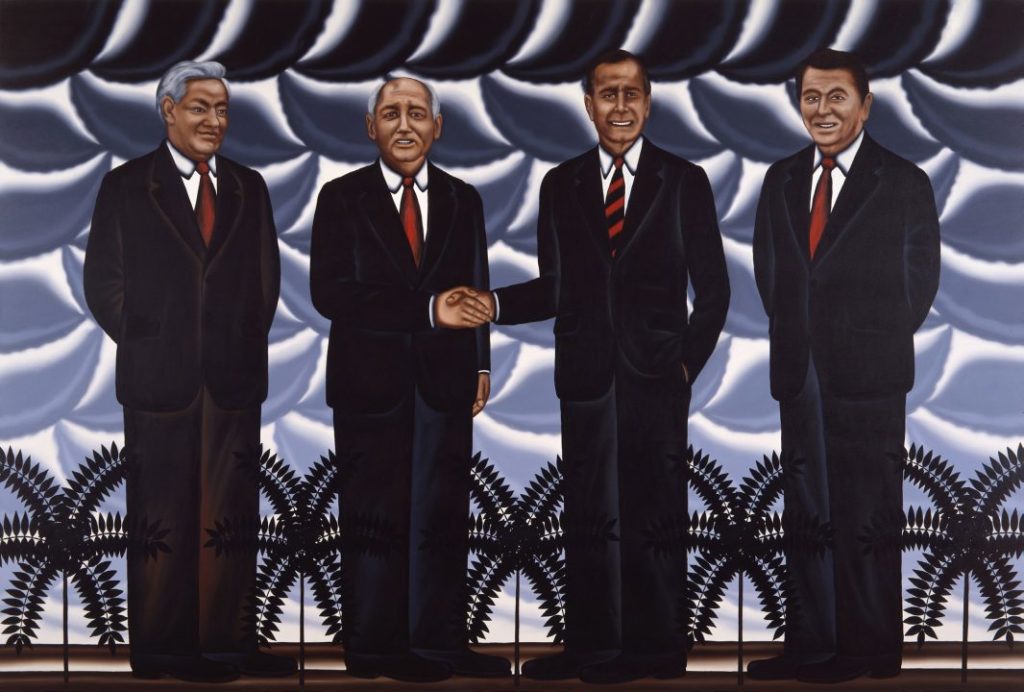
Among the standouts are works by a painter from Botswana and a central figure in the Pictures Generation.

Brian Boucher

The sixth edition of the Expo Chicago fair, Tony Karman’s revival of the long-standing but lapsed Art Chicago, lured first-timers like Lévy Gorvy and Larry Gagosian, demonstrating that even international titans are happy to bring their wares to the Windy City. Below are seven works that make the fair unmissable.
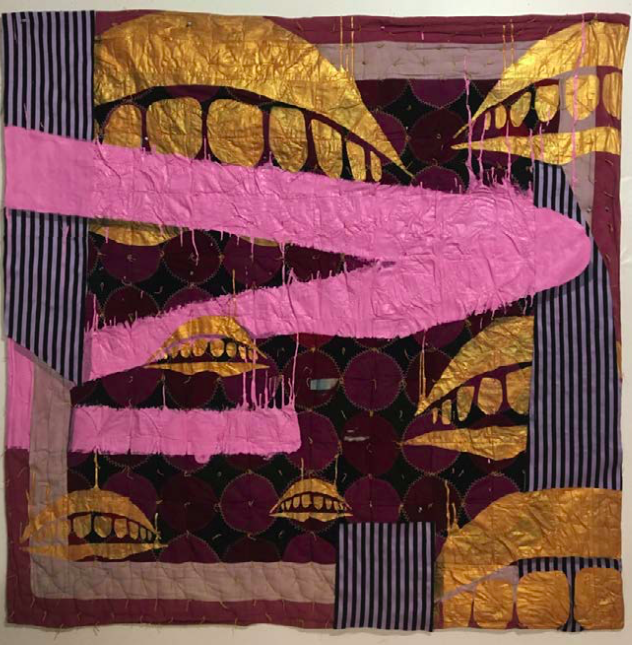
Sanford Biggers, Grip & Grin (2017). Courtesy moniquemeloche, Chicago.
Quilts created by African women in America during the 19th century served purposes far more urgent than warmth or decoration. Displayed outside of a house, they conveyed vital messages to former slaves traveling via the Underground Railroad about whether the house could offer safe harbor or not. Over these objects, with their great emotional heft, Sanford Biggers paints abstract shapes in acrylic. Onto Grip & Grin (2017), he has painted a toothy grin, a common image for him, which he associates with both minstrelsy and the Cheshire cat, but inverted, so that it becomes moodier, sexier. Judging by the upward-reaching drips of the paint, the inversion may have been a last-minute decision. Standing before the work at the fair’s preview on Wednesday, the viewer couldn’t escape the sounds of gunshots from a video nearby, in which Biggers brutalizes African sculptures.
Grip & Grin bears an asking price of $50,000, and, according to Meloche, it was on hold for a museum 90 minutes into the preview. Biggers is also currently the subject of an exhibition at New York’s Marianne Boesky Gallery.
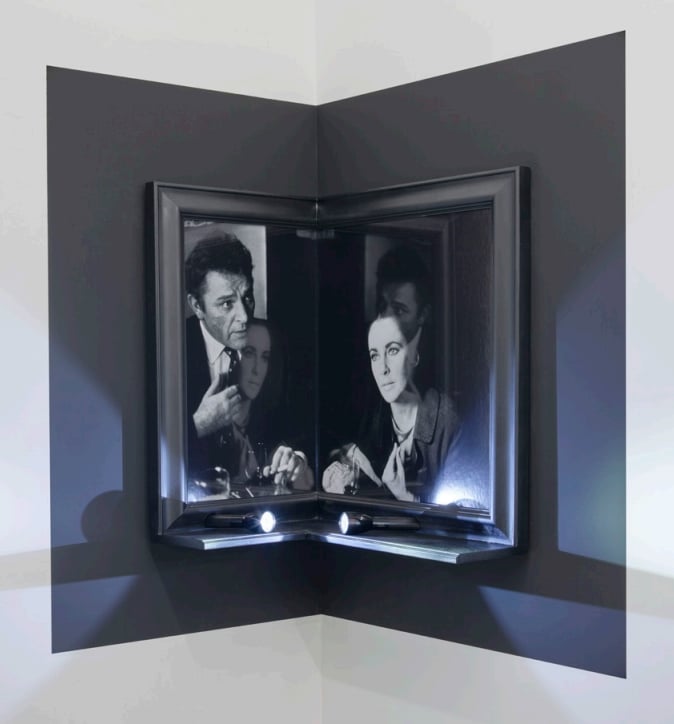
Barbara Bloom, Beacons (Liz and Dick) (2017). Courtesy of the artist and David Lewis Gallery.
Though a key figure in the Pictures Generation, whose work resides in museums from MoMA to the Yokohama Museum of Art, Barbara Bloom curiously hasn’t achieved the same star status as some of her peers. She is distinct from her Pictures cohort in her interest in sculpture, and the spellbinding work here, Beacons (Dick and Liz), from this year, features a photograph of a worked-up Richard Burton and a radiant Elizabeth Taylor snapped by Eve Arnold at an English pub in 1962. The two face each other across a 90-degree angle as if at the corner of the bar. They seem no less disconnected for the flashlights that rest on a shelf below them, as though they were searching for each other in the dark. The asking price is $45,000.
The artist sustained life-threatening injuries when she fell out a window in the mid-90s. Another work here, Broken (Teapot), from 2001, features a celadon object broken and then mended with gold in the Japanese Kintsugi style.

Roger Brown, The War We Won (1991). Courtesy of the artist and Kavi Gupta gallery.
The smiling figures of Boris Yeltsin, Mikhail Gorbachev, George H.W. Bush, and Ronald Reagan loom at seemingly giant size in Roger Brown’s painting The War We Won (1991). The artist, most commonly associated with the Chicago Imagists, was referring by comparison to the Vietnam War, although the war on drugs, also a loss, comes to mind as well. As they smile and shake hands two years after the fall of the Berlin Wall, one wonders whether these four men could have imagined the tensions between their two countries now.
Featured in a lengthy roster of American museum collections from New York’s Metropolitan Museum of Art to the Los Angeles County Museum of Art, Brown’s work also took on subjects like the Gulf War, the Red Scare, and the Savings & Loan crisis of the 1980s and ‘90s, none of which, he might not be surprised to learn, have fully left us.
The work is part of Brown’s estate, which was willed to the School of the Art Institute of Chicago, the artist’s alma mater, but came into Kavi Gupta’s hands about a year ago. It’s not for sale.
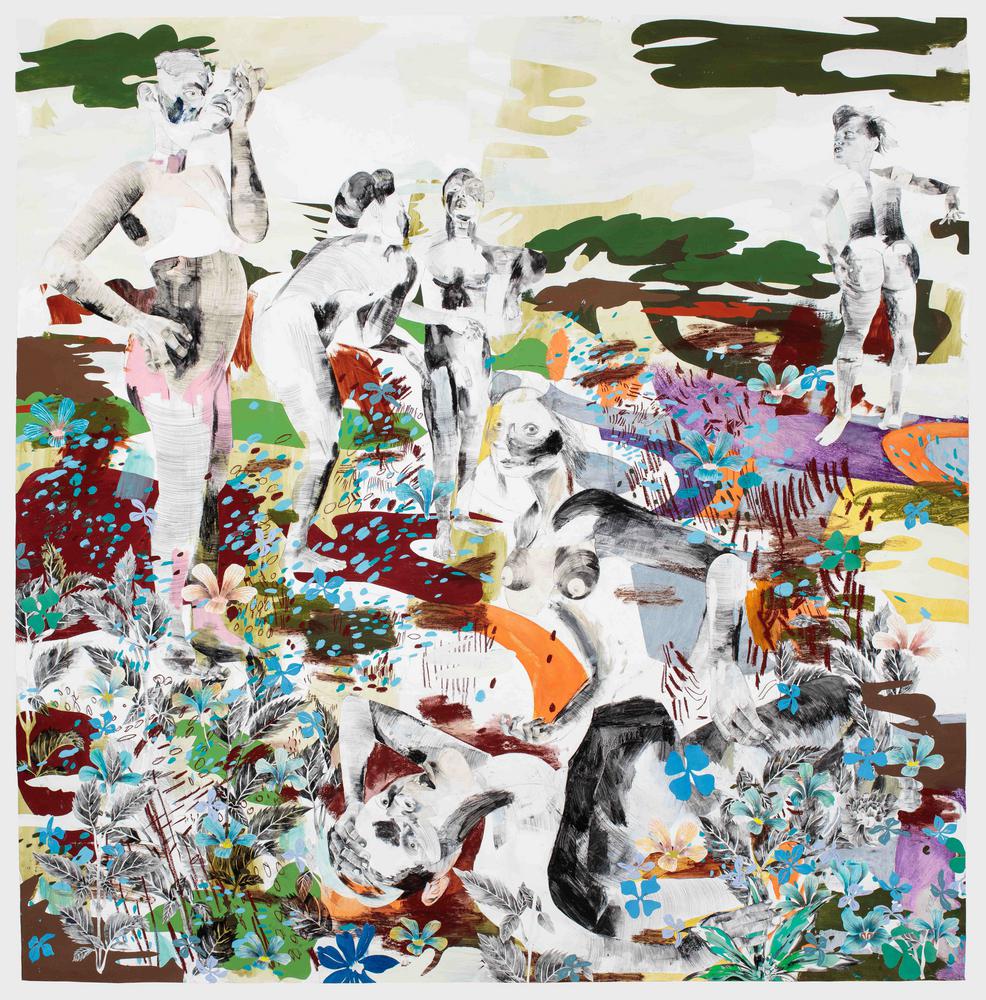
Wardell Milan, The new sun will warm our proud and naked bodies (2016). Image courtesy of the artist and David Nolan Gallery.
One of the young artist’s largest works to date, The new sun will warm our proud and naked bodies (2016) is richly layered, constituted from painted, drawn, and collaged elements. Several nude figures populate a verdant landscape, evoking a rich Western tradition. Individual body parts from one drawing get cut out and collaged into another, imparting a sort of fragmentation and violence to the figures, even as they exhibit beauty and a certain nobility. Typical of the artist’s literary inspirations, the work’s title is an adaptation of a line from an Audre Lorde poem. A Tennessee native, Milan earned an MFA from Yale and has lived in New York since a residency at the Studio Museum in Harlem. The work’s asking price is $40,000.
Botswana-born Meleko Mokgosi likes to work big; one multipanel painting of his extends to some 60 feet long. The works on paper on view at Honor Fraser’s booth are as wide as 12 feet, on a single sheet. Mokgosi may have made his initial art-world splash when he won the inaugural Mohn Award at the Hammer Museum’s Made in L.A. biennial in 2012 (for that 60-foot canvas), but he had already had a residency at the Studio Museum in Harlem and earned an MFA at UCLA. This was after completing the Independent Study Program at the Whitney in New York, and the Affiliate Independent Study Program at London’s Slade School of Fine Art, no less. In a mesmerizing untitled 12-foot drawing here, two seemingly identical men in black suits flank a woman in a wedding dress. All are mysteriously stone-faced. Wide swaths of untouched paper abut brushy treatments of a lemon-yellow wall, hung with portraits. Some come from the artist’s family, some from the newspapers of his home country. Mokgosi often treats the cruel history of British colonialism in Botswana, but here, he seems content to give his inscrutable figures a grand stage from which to gaze on the viewer. The works on offer range from $20,000 to $45,000. The untitled work with the three figures, dating from 2016, is tagged at $30,000.
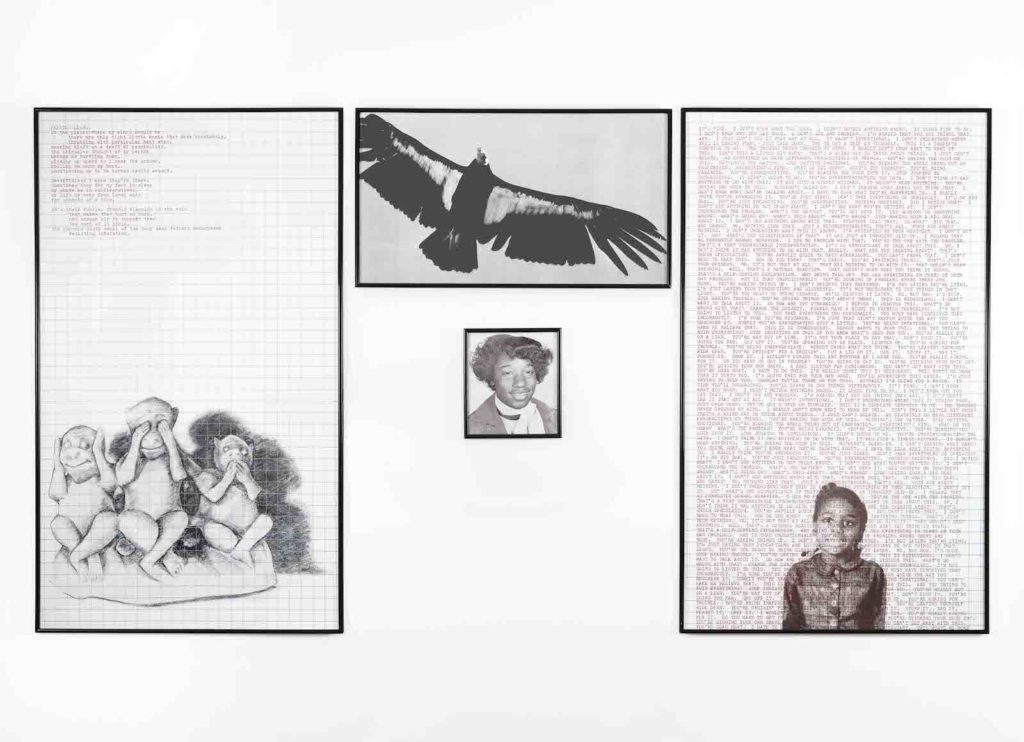
Adrian Piper, Decide Who You Are # 21: Phantom Limbs (1992). Silkscreened image-text collage printed on paper mounted on foam, silkscreened texts. Four panels: 42″ x 72″; 43 “x 24″; 13″ x 15″; 42″ x 72” , (106,7 x 182,8; 109,2 x 61 cm; 33 cm x 38,1 cm; 106,7 x 182,8). #92005.1-4. Photo credit: Galerie Christian Nagel. Collection of the Adrian Piper Research Archive Foundation Berlin. © APRA Foundation Berlin.
Characteristically tough, Adrian Piper’s large, multi-panel work Decide Who You Are (1992) includes images of two women who fell victim to men’s misdeeds. On one panel is a young Anita Hill, who would go on to be at the center of a national firestorm when she accused then-Supreme Court nominee Clarence Thomas of sexual harassment. Superimposed over her face—and dominating the image—are dismissing words like: “You’ll get over it”; “Stop making such a big deal.” At the center of the image is a smiling portrait of a black woman who was the victim of a brutal murder. Unwilling to face the misogyny are the occult figures, “The Three Wise Monkeys,” to the left. The title seems to challenge the viewer not to do the same.
The work’s price is €185,000 (about $220,000). The piece is promised to a major exhibition at New York’s Museum of Modern Art next year. Piper is also the subject of an exhibition opening next week at the dealers’ New York gallery.
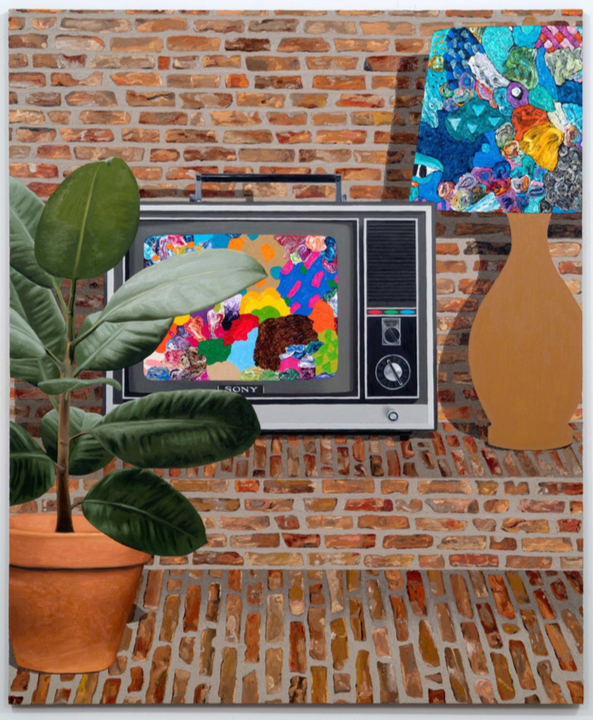
John Seal, All That I Touch is Touched by the Sun 1 (2017). Courtesy König Galerie, Berlin.
Devoted solely to works by this 40-something artist, König’s booth is marked by an excellent strangeness. Seal’s works combine painting and sculpture: On a platform in the center of the booth stand a sculpture of a lamp—its base beautifully finished walnut, its shade an abstract painting on shaped canvas—and a large wood sculpture of a television, whose screen is similarly painted. Both objects are then echoed in a painting in which they stand before a brick wall that echoes that of the Berlin gallery, in a pleasing play of two- and three-dimensional, near and far.
After studying at Bard College and Skowhegan in New York State, Seal fled what he felt to be New York’s strictures and decamped to Los Angeles, where König discovered him in a show at Laura Owens’s 356 Mission space. Asking prices for the sculptures are in the $10,000 to $15,000 range; the paintings are $23,000.